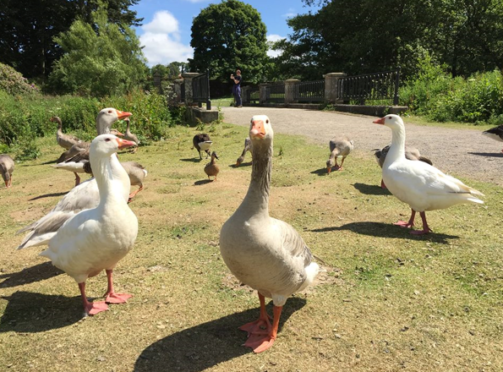A popular north-east attraction, well-known for its wildlife, has waded into a debate about whether or not people should feed bread to water fowl.
Haddo Country Park is famed for its vast ponds and is a beloved destination for families with small children who flock there at weekends to feed the ducks, geese and swans that live there.
Traditionally, bread has been the food of choice for youngsters to dish out at the pond side, but in recent times this has been discouraged by Haddo’s park staff as they maintain it can endanger the birds.
>> Keep up to date with the latest news with The P&J newsletter
However, the Queen’s Swan Marker this week waded into what has become a national debate and said there was “no good reason” not to feed bread.
David Barber said that in his opinion the bakery products dished out were safe for waterfowl and swans and that stopping such feeding might even be damaging the population UK-wide.
That has prompted Haddo to release a statement of their own, with visitor services officer Suzanna Atkinson saying the contrary advice felt like “a backwards step”.
She said: “At Haddo we work very hard to educate and inform visitors about responsible wildlife feeding.
“We run regular wildfowl awareness events, sell bird seed in the shop and have signs up to encourage people to feed seeds, peas, sweetcorn, lettuce and oats to the birds – and to discourage feeding bread.
“Bread has very little nutritional value for birds, so although they love to eat it – just as kids like to eat sweeties – it doesn’t help them to flourish.
“It also causes problems with the water.
“This years’ dry weather encouraged hundreds of geese to rehome at Haddo and hundreds of geese mean thousands of droppings.
“Feeding them bread makes them defecate even more than normal, while feeding them seeds makes their waste less prolific.
“The result of all this waste is a massive increase in algae, which is not only bad for all the creatures that live in the lake, but the spores can get into the birds’ lungs and kill them.
“It also clouds the water, which means the sun cannot penetrate it so the water plants – the stuff the birds should be eating – do not grow as much and the problem is exacerbated.”
The Queen’s Swan Marker, David Barber MVO, said: “There has been a great deal of press coverage in recent months regarding the ‘Ban the Bread’ campaign which is confusing many members of the public who like to feed swans.
“Supporters of the campaign claim that bread should not be fed to swans on the grounds that it is bad for them. This is not correct.
“Swans have been fed bread for many hundreds of years without causing any ill effects. While bread may not be the best dietary option for swans compared to their natural food such as river weed, it has become a very important source of energy for them, supplementing their natural diet and helping them to survive the cold winter months when vegetation is very scarce.
“There is no good reason not to feed bread to swans, provided it is not mouldy.
“The ‘Ban the Bread’ campaign is already having an impact upon the swan population. I am receiving reports of underweight cygnets and adult birds and a number of swans from large flocks have begun to wander into roads in search of food.
“I therefore encourage members of the public to continue feeding swans to help improve their chances of survival, especially through the winter.”
Swan Upping
Mute swans have long been considered regal birds but, contrary to popular belief, not every swan in the UK is owned by the Queen.
A ceremonial census – Swan Upping – is carried out on the Thames every year and any unmarked birds are considered royal property. They are then corralled, caught and marked.
The ancient tradition of counting swans along Britain’s most famous waterway takes a team of boatmen – called the Swan Uppers – around five days to cover 79 miles of riverbank.
The ritual dates back to the 12th century when the ownership of all unmarked mute swans in open water in Britain was claimed by the Crown in order to ensure a ready supply for feasts.
In an average year, about 1,000 birds are counted by the Swan Uppers.
